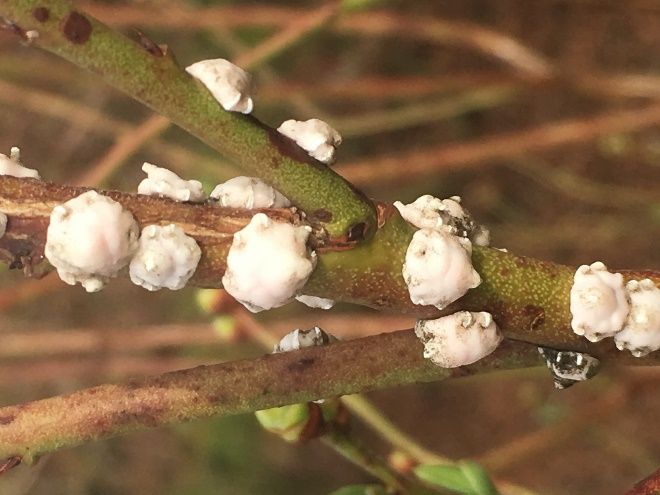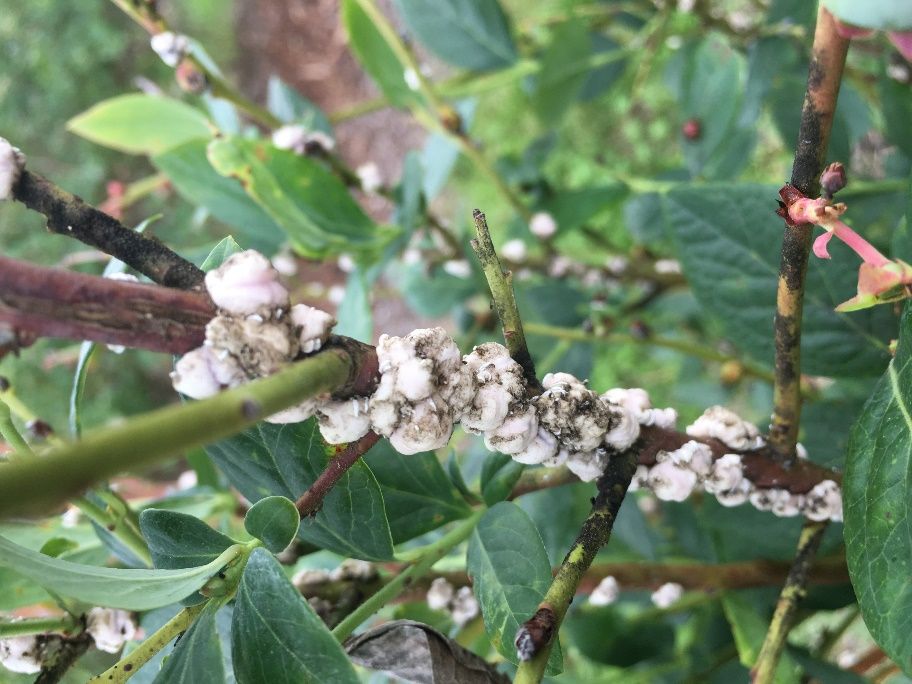Wax scale is an insect pest on southern highbush blueberries in Florida. This publication is intended to provide Florida blueberry growers with descriptions to help with identifying this pest, information about its life cycle, and suggestions on how best to manage it.
Florida wax scale, Ceroplastes floridensis Comstock, is thought to have originated in the northern neotropical region, which encompasses an area from central Mexico through South America and the Caribbean. It is now observed across the world (Sharma and Buss 2018). It is an insect pest causing damage on plants throughout much of the United States, including Florida, where it can be found infesting southern highbush blueberries (Vaccinium corymbosum L x V. darrowi Camp). Adults are very small and reddish brown, covered in a thick white, gray, beige, or pinkish coat of wax that typically becomes dirty white over time. Including the wax covering, they are less than 1/4 inch long (Figures 1 and 2). These insects are all female (there are no known males of this species) (Futch et al.).

Credit: D. Phillips, UF/IFAS

Credit: D. Phillips, UF/IFAS
Injury
Florida wax scale feeds on blueberry plants (primarily the stems) by inserting sucking mouth parts into the plant and removing large amounts of plant sap. With significant infestations, the stems display a mottled appearance, and heavy feeding weakens the plant and causes premature defoliation and stem dieback. In addition, wax scale secretes a sugary substance called honeydew that can promote the growth of a black fungus known as sooty mold, which reduces photosynthesis, further weakening the plant.
Life Cycle
Three generations of this insect occur annually in Florida, the first appearing in mid to late spring, the next in summer, and the third in fall. Each generation begins with the female laying eggs under its wax coating, which hatch in 2 to 3 weeks. The nymphs are referred to as crawlers (Figures 3 and 4). This is the mobile phase of the wax scale’s life, when the nymphs move from under the female to settle on other stems or leaves, and begin to feed and secrete a wax coating. Once the nymph inserts its mouthpart into the plant and begins to feed, it remains in place for the rest of its life. There are two additional instars in the nymph phase, and after laying eggs, the adult dies. Each generation lasts between 3 and 4 months (Sharma and Buss 2018).

Credit: L. Buss, UF/IFAS

Credit: L. Buss, UF/IFAS
Management
Cultural Controls
Infested plant parts should be pruned and destroyed. Post-harvest hedging in June can help remove wax scale infestations. For small infestations, wax scale can be removed by hand and destroyed.
Biological Controls
Biological control agents include parasitic wasps in some parts of the United States such as Coccophagus lycimnia Walker, Metaphycus eruptor Howard, and Scutellista cyanea Motschulsky (Drees et al.).
Chemical Controls
For remaining infestations or those occurring after hedging, pre-bloom applications of superior horticultural oil (e.g., JMS Stylet Oil, JMS Flower Farms, Inc.) can be used for control. Multiple foliar spray applications at 7- to 10-day intervals, or as instructed on the product’s label, may be necessary for control and to protect new foliage from becoming infested. Make sure to follow all label directions, as application during summer or other times when temperatures exceed 85F or in winter when temperatures are lower than 40F can result in burning of plant tissues. All applications should be made pre-bloom; if floral buds have begun to break, use of horticultural oil should be avoided.
A soil application of imidacloprid (e.g., Admire Pro) can be used to reduce scale populations. Diazinon has some effectiveness on the nymphal stages. Some Florida growers have reported success using applications of Thiamethoxam (Actara). Contact insecticide sprays are generally ineffective on adult wax scale due to the thick wax coating covering the insects. However, contact spray can help to reduce populations if application is made during the crawler stage. All label instructions should be followed when applying any of these products.
Table 1 lists registered pesticides that should be integrated with other pest management methods. Additional information on integrated pest management methods can be requested from UF/IFAS Extension horticulture or agriculture agents. A list of local UF/IFAS Extension offices is at available at https://sfyl.ifas.ufl.edu/find-your-local-office/.
Table 1. Registered pesticides that should be integrated with other pest management methods.
References
Drees, B., J. Reinert, and M. Williams. 2006. “Florida Wax Scale: Control Measures in Texas for Hollies.” Publication L-5479, Department of Entomology, Texas A&M AgriLife Extension Service.
Futch, S., C. McCoy, and C. Childers. 2018. “A Guide to Scale Insect Identification.” HS-817. EDIS 2018.
Sharma, S., and E. Buss. 2014. “Florida Wax Scale.” EENY-510. EDIS 2014.